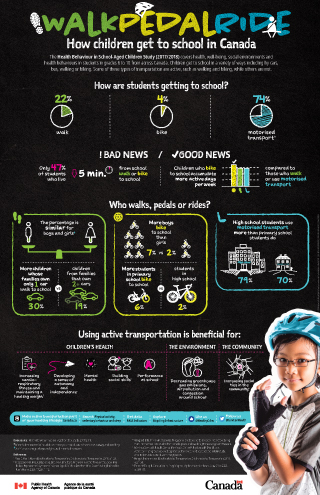Active transportation - How are children getting to school?

Download the alternative format
(PDF format, 11.6 MB, 1 page)
- Organization: Public Health Agency of Canada
- Date published: January 2023
The Health Behaviour in School-Aged Children Study (2017/2018) covers health, well-being, social environments and health behaviours in students in grades 6 to 10 from across Canada. Children get to school in a variety of ways including by cars, bus, walking or biking. Some of these types of transportation are active, such as walking and biking, while others are not.
How are students getting to school?
- 22% walk
- 4% bike
- 74% use motorised transportFootnote *
The good news:
- Children who bike to school accumulate more active days per week compared to those who walk or use motorised transport
The bad news:
- Only 47% of students who live less than 5 minutes from school walk or bike to school
Who walks, pedals or rides?
Among children who walk to school:
- The percentage is similar for boys and girlsFootnote †
- More children whose families own only 1 car walk to school (30%) than children from families that own 2 or more cars (19%)
Among children who bike to school:
- More boys bike to school (7%) than girls (2%)
- More students in primary school bike to school (6%) than students in high school (2%)
Among children who use motorised transport:
- High school students use motorised transport more (79%) than primary school students do (70%)
Using active transportation is beneficial for:
- Children's health, by:
- increasing cardiorespiratory fitness and maintaining a healthy weightFootnote 1
- developing a sense of autonomy and independenceFootnote 2
- improving mental healthFootnote 2
- building social skillsFootnote 3 and
- improving performance at schoolFootnote 4
- The environment, by decreasing greenhouse gas emissions, air pollution and congestion around schoolFootnote 5
- The community, by increasing social tiesFootnote 6
Make active transportation part of your healthy lifestyle
Learn more about active transportation at Canada.ca
- Search Physical activity, sedentary behaviour and sleep
- Get data at PASS indicators
- Explore the Bicycling Infrastructure
- Like us on Facebook at Healthy Canadians
- Follow us on Twitter at @GovCanHeath
Data source: Health Behaviour in School-Aged Children Study, 2017/2018.